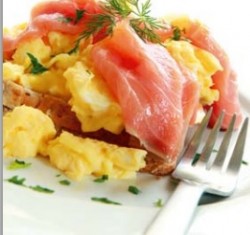Christmas is a time of great excitement. It is a time for family and for children, for lights, for decorations, Santa presents and of course for food! Rich delicious foods are a huge part of the traditional Irish Christmas. Piles of roast potatoes, the turkey and ham, the Christmas pudding soaked in brandy and a Christmas cake to top it off. So how do you get through the festive season without completely over-indulging?
Healthy eating for people with diabetes is the same as for everyone else. All of the traditional Christmas foods such as mince pies, Christmas pudding and Christmas cake can still be enjoyed but just don’t eat too many or too much in one go. The trick is to spread them out over the Christmas period and keep your portions as small as you can.
So here are some tips to help you eat healthy this Christmas and keep your diabetes on track.
 For Children
For Children
For children it is the most exciting time of year because Santa is on his way! For children the emphasis is more on school holidays and presents rather than all the sweet stuff. It just happens that chocolates and overeating has become part of the tradition for everyone. It doesn’t have to be though, remember it’s only one day!
With chocolates and sweets, it is best to restrict them. Selection boxes and tins of sweets don’t have to be eaten in one day. They are best eaten in small amounts after meals. Chomp, Curly Wurly, Slim dairy milk and Fudge bars are small and are lower in fat, calories and carbohydrate, so encourage these as treats. This will help them to control their blood glucose.
If Santa is bringing a bike, skates or scooter, try to get out and play with them for at least an hour every day. Otherwise get some fresh air by walking with your family for an hour every day over the holidays.
Top tips for a healthy Christmas
- Stick with sugar free or diet drinks as much as possible. Keep fresh fruit juice to a small glass taken with a meal as it contains lots of natural sugars.
- Save your selection boxes and tins of sweets- they will last into January and don’t need to be eaten all at once.
- Love the Christmas fruit and veg! Fruit salad, melon, satsumas, fruit juice, parsnips, carrots, peas, brussel sprouts, broccoli and dried fruit (only a small handful). Make sure you have your share of these too over Christmas not just crisps, chocolate and cake!
- Take some exercise to walk off the large meals and puddings. Save the DVD’s and computer games until its dark and get outside when you can.
- Take your time when eating; slow down especially at this time of year. You usually eat more when you eat quickly and slowing down will help you to reduce the amount you take in.
- Fried food can be easily avoided by roasting or grilling. Avoid adding butter to vegetables, and keep an eye on how many sauces you eat. When eating out ask for sauce on the side so you can control the amount you take in.
- If you are on insulin or on a pump and will be snacking more or having a larger dinner discuss altering boluses or injections with your diabetes team.
 Festive Breakfast Ideas
Festive Breakfast Ideas
Here are a few easy suggestions as to what foods you can eat for breakfast when you have diabetes:
- Porridge with flaked almonds and strawberries and 1 teaspoon of cream
- Brown soda bread and 2 slices of lean bacon or salmon and slices of grilled tomato
- Yoghurt topped with fresh fruit compote and wholegrain cereal
- Poached or scrambled egg and smoked salmon with a small wholegrain bagel and fresh fruit juice
- Wholemeal pancakes topped with yoghurt and chopped fresh fruit
- Wholemeal pancakes drizzled with a small amount of honey and chopped fresh fruit
- 2 slices of wholegrain toast with jam (you only need a little) and freshly squeezed orange juice
- Scrambled eggs, grilled tomato and mushrooms with half a bagel
- Fresh fruit smoothie with 1 slice of rye bread and a small amount of chunky marmalade
- No added sugar muesli with natural yoghurt and a small glass of fresh orange juice.
- For starters try melon and other fresh fruits with Parma ham or smoked salmon or have avocado and prawns with a lightly dressed salad
- A delicious homemade soup can be a warming low calorie starter
- Try adding some seasonal butternut squash and top with low fat crème fraiche and some fresh parsley rather than cream
- Turkey meat is naturally low in fat, however avoid the skin as this is high in fat
- When roasting potatoes leave them whole rather than cutting them small as the smaller they are the more fat they will absorb. Roast separately from the turkey to cut down on the animal fat
- Fill up on plenty of vegetables but avoid adding butter or rich sauces. Steam your vegetables rather than boil to hold onto those valuable vitamins and minerals
- Gravy is a must for turkey but allow the juices to settle so you can skim off all fat before making
- Use low fat custard or crème fraiche instead of cream or brandy butter with the pudding
- Try fruit compote by stewing your favourite berries with plums and apples with a pinch of cinnamon
- Most importantly keep the ‘goodies’ to small portions and when you feel full stop eating!
Healthier Nibbles
- Satsumas and other seasonal fruits such as mango
- A small handful of unsalted nuts
- Chestnuts are the lowest fat nut
- Reduced fat crisps, popcorn or pretzels
- Dried fruit such as dates, figs or apricots.
- Bread sticks with tomato salsa or low fat yoghurt dips.
Diabetic chocolate
‘Diabetic’ chocolate is not recommended, it is expensive and unnecessary. Diabetic chocolate contains fructose, sorbitol or a similar sweetener which can have a laxative effect. It is also just as high in fat and calories as ordinary chocolate, and can still raise blood-glucose levels. So if you are having some chocolate over Christmas, have small amounts of ‘normal’ chocolate after meals to control your blood glucose level.
 Exercise, Exercise, Exercise!
Exercise, Exercise, Exercise!
We are all going to indulge a little over the holidays. Whether you have type 1 or type 2 diabetes, exercise helps keep your glucose under control. Do consult your doctor before beginning an exercise program. Also, make sure that you have an understanding of how exercise affects your blood glucose, especially if you use tablets or insulin.
Why not:
- Check what’s on in your area on Christmas day or Stephens Day. If there is a local sponsored swim maybe take a walk there to offer support or why not even take part yourself!
- Despite the risk of low blood glucose, exercise is a valuable tool in managing your levels
- If you manage diabetes without medication or insulin, a brisk walk before or after a meal will help reduce your blood glucose levels. So grab the dog or your family and enjoy a Christmas Day walk.
- At a party, keep your mind off all the treats being served by dancing the night away.
- Even if you manage your diabetes with medication, exercise can help reduce your blood glucose, and helps with losing any weight gained over Christmas.
- We do more drinking at Christmas than at any other time of the year and alcohol is a big problem if you are trying to keep your weight stable
- Not only does it contain calories (one pint of beer has around 200 calories) it can also lead to low blood glucose, which makes you feel hungrier
- Never drink on an empty stomach and always have a snack at bedtime after alcohol as it can lower the blood glucose levels the next morning
- If you are drinking make sure people around you know you have diabetes and always carry or wear some form of identification
- Choose sugar free mixers and avoid alcopops. Have a glass of water or diet drink for every second drink, this will not only reduce the calories, but will also help the hangover
- Making a wine spritzer by mixing wine with diet lemonade or soda water is another way to cut back on calories
- If you have a lot of parties to go to try not to drink at all of them – and bringing the car with you has the added benefit of not having to queue for taxis
- Enjoy Christmas and New Year, it is a time for celebration and eating for everyone. A little of what you fancy over Christmas and an odd high glucose reading should not affect your long term control or health.
Download our Christmas tips leaflet here – Christmas and your diabetes


